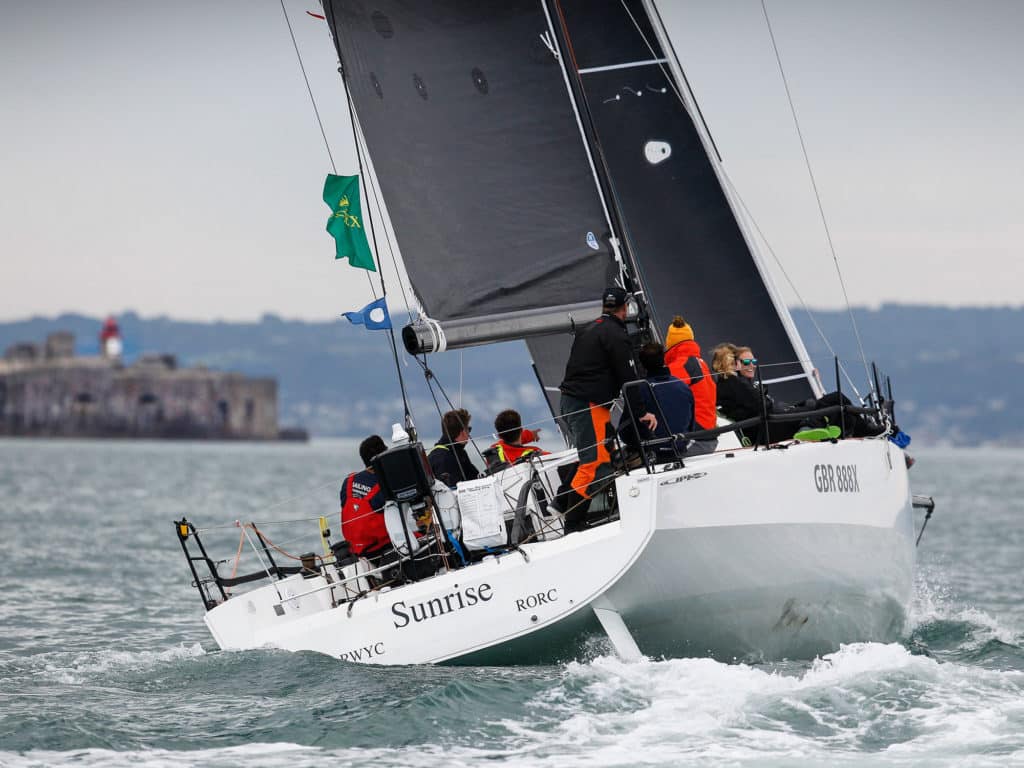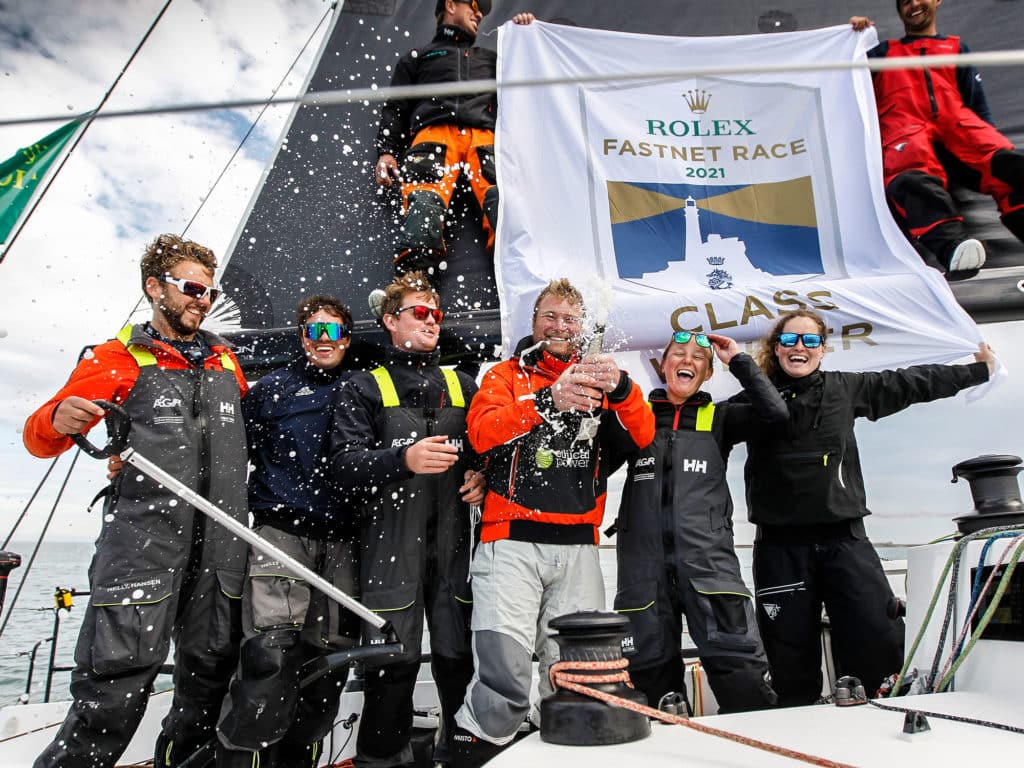
Seven years ago, Tom Kneen bought a 34-foot Elan production boat to race offshore, and named it Sunrise. At the time, he had no idea what it would lead to. Kneen, a renewable energy entrepreneur, was only 29 years old, and the young team he cobbled together competed in the Royal Ocean Racing Club’s Season Points Championship, and placed 175th in the 2015 edition of the Rolex Fastnet Race. They were just another team bringing up the rear.
Two years later, however, Kneen upgraded the Sunrise program to a sportier JPK 1080, this time placing 60th in the famous race. For the 2019 running, he ramped up again—this time with a brand new JPK 1180. Finishing 20th, the team’s trajectory was clear and convincing. Then, in the summer of 2021, the 36-year-old skipper finally won the Rolex Fastnet Race overall, beating 263 boats, including many of world’s best professional offshore teams.
“To be honest, I can’t really tell you why we won the Fastnet, and it still hasn’t sunk in,” Kneen says months later. “Fundamentally, we didn’t do anything clever, and that is why it was such a shock. I look at that trophy in my living room and think, ‘What is that doing here?’ When I look at the names on that trophy it’s just unbelievable.”
What makes Sunrise’s meteoric rise even more extraordinary is that the crew, bar one professional, is not paid to race, and there is not a grey hair on board.
“Nobody knew Sunrise in 2015. We were at the back of the fleet and all the winners had gone home by the time we finished,” Kneen says. “In 2019, I remember talking to Gery Trentesaux who had won the race overall in 2015 with the JPK 1080 Courrier Léon and in 2019 won IRC 2 with the JPK 1180 Courrier Recommandé. Gery said that Sunrise would never sail as hard as Courrier Recommandé, that we would never do what was required to be better than him. Right now, I think we might be better. I think that the process we have been through in the last three years has been utterly amazing.”
The big change for Kneen came in 2018 when he commissioned the current Sunrise—the 1180. The previous boat was ideal for he and Francesca, his partner and now mother to their son Samuel. They could race competitively inshore and offshore, as well as cruise shorthanded. Initially, he was only after a slightly bigger boat, but what transpired was very different indeed.
“I could barely afford an 1180, but we got a good deal on the previous boat and the exchange rate helped,” he says. “When we took the 1180 out for its first sail, it was clear that it did things that nobody would believe possible for a 39-foot boat—25 knots downwind!”
Specifying gear for the 1180 was unfamiliar territory for the team and Kneen says they “broke a lot of stuff” in the early days. “The 1180 was far more than a slightly bigger boat and the idea that we could put on some cockpit cushions and go cruising went right out of the window,” he says. “The 1180 is a totally different animal.”
Disaster struck for Sunrise in August 2020 while racing in the RORC Summer Series. The boat dismasted in big breeze, but the destruction of the rig paved the way for modifications, which took the boat’s performance to a new level.
“In previous boats, we had always tried to reduce the IRC rating, but I concluded that this was a boat where that wasn’t the case at all,” Kneen says. “The 1180 wasn’t a bandit IRC boat when we bought it—initially we didn’t have it right. The new rig could be jacked hydraulically. This cost us in IRC rating, but it more than compensated with the added performance.”
The stock 1180 was configured for symmetric spinnakers and had a short sprit for a Code Zero. “To maximize VMG we felt we were sailing too low downwind,” Kneen says. “So, we reconfigured the boat to asymmetric with a longer bowsprit and upgraded all of the deck systems to cope with the ballistic performance. With regards to sail design, we went to North Sails and the scope was to make it the fastest boat in IRC 2. We identified areas of weakness and addressed those issues, and having said all that, the biggest constraint was budget. We had to spend wisely, juggling, and balancing what we could afford.”

Modifications below deck were designed to make the interior tidier and more comfortable. “I am really into crew preservation,” Kneen says. “Having a wet locker for foul-weather kit and sleeping bags makes a huge difference. All this keeps the crew at their best for when we needed to dig deep, to push hard.”
The original rudders were the same size as the 1080 and the boat tended to spin out at high speeds. Later 1180s were been built with longer rudders, so Kneen followed suit. They also added a system that allowed them to adjust the rudder angles, reducing drag on the windward rudder.
Sunrise has a core crew of six: Tom Cheney and Suzy Peters, both data analysts, share navigation duties. Law school graduate Tor Tomlinson is primarily the mainsheet trimmer and manages the boat with Tom Cheney. Angus Gray-Stephens is the boat’s bowman and all-rounder. The only paid crew is Dave Swete, a two-time Volvo Ocean Race veteran. The core six, forming the nucleus for the 2021 Rolex Fastnet squad, were joined by two young aspiring sailors: Quentin Bes-Green and George Kennedy. All of the crew, including Kneen, were in their 20s and 30s.
“In 2019, Dave [Swete] said he wanted to race with us, but I said I didn’t want to sail with professionals,” Kneen says. “He sailed the first race for free and he did make a big difference to our performance. Since then, he has become emotionally attached to Sunrise and has said it is the most rewarding sailing he has done, so that is why it works.”
Paying multiple people to sail is not a formula for success, Kneen says because, “They are not there for the right reasons. We go racing because we want to be together. This completely changes the agenda because everyone gets much more involved. My crew spend their evenings trawling over polar charts and data and they don’t count the hours. The crew do this because they love it, they are all emotionally attached to the boat. My view is that the best crew is a combination of one or no pros and the rest top amateurs. Give that crew an exciting program of races and you have a winning combination.
Francesca, he adds, is very much part of the team. “You have to have a strong partner in life,” he says. Without her managing the home and the family, Kneen says, Sunrise would never leave the dock.
A couple of decisions before the 2021 running of the Fastnet did make a huge difference, Kneen says. “The week before the race, Tom and Suzy installed a sat-com system that would allow us to get weather data in the Celtic Sea. The confidence in that data got us the right side of two shifts. At Lands’ End, we were level with the other 1180s, by the Fastnet Rock we were ten miles ahead.”
Toward the end of the race, Sunrise was one of the last teams to make it across a pressure ridge and stay in the breeze. This critical point in the race was, of course, made possible by their performance in the earlier stages.
“We actually broke our masthead halyard lock before we rounded the Fastnet Rock, so we were under canvassed racing south toward the finish,” Kneen admits. “We were probably half a knot slower, and trying to keep ahead of the ridge, plus we spent a lot of time creating a temporary fix so that we could fly our Code Zero. The breeze came in and we were in 25 knots downwind for four hours and that put us in the game. That, for me, was the highlight of the race. I love the boat when it’s going fast downwind.”
When they arrived at the Channel Islands, the tide turned in their favor. The breeze was dying but the tide swept them south of Alderney where they got “picked up and hurled at the mainland coast.”
Their boatspeed at the time was 4 knots, but with 7 knots of tide beneath them their VMG was 10 knots. “The crew had slept during the early part of the race, so everyone was up for the last 160 miles,” Kneen says. “We were fresh, we knew what we needed to do, and we had the data to tell us we could achieve it. I had genuinely joked with Francesca that I would win a Rolex—I didn’t really believe it would happen. For decades, many people have tried to win this race, this victory has put us all in a very privileged club. This amazing group of people have achieved something they will remember forever.”









